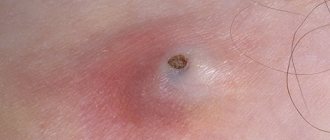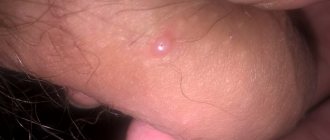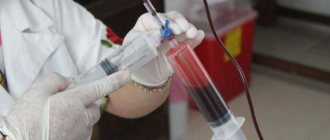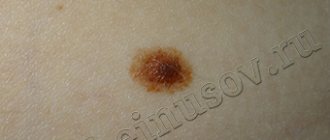Atheroma (atheroma), translated from Greek means tumor and mush, and is an epithelial cyst of the skin, which has several types: retention cyst, epidermal, multiple steatocystoma and trichilemmal cyst.
The clinical signs of all these subtypes are the same, and therefore they are often called atheromas.
This round tumor has a capsule inside filled with thick yellowish-white masses with a repulsive odor. The walls of the atheroma produce keratin, which is its content.
This skin disease occurs in approximately ten percent of the population, most of them in the fair sex. Middle-aged people are also most susceptible to developing atheromas.
They appear, as a rule, randomly or are inherited, although science has not yet identified the genes that are responsible for such formations.
What is atheroma
A round neoplasm in the layers of the skin is easily detected - it has clear boundaries and moves when palpated. Atheroma is a benign tumor that occurs when the sebaceous gland is blocked. Substances that form inside cannot come out. The body reacts to this process by creating cavities from the connective tissue - cysts - a place where secretions accumulate. The blocked duct enlarges, the size of the capsule can reach 20 centimeters.
The tumor can occur on any part of the body where a large number of sebaceous glands are located. It is unpleasant when atheroma - a wen - is in a visible place, being a cosmetic defect. If the inflammatory process has not begun, touching it is painless. Localization occurs on:
- armpits;
- scalp;
- crotch area;
- back between the shoulder blades;
- mammary gland;
- buttocks;
- shoulders;
- face;
- popliteal fossa;
- back of the head;
- behind the ears.
In what cases is it necessary to get rid of this neoplasm?
You may be interested in: The grooves and convolutions of the brain - meaning and functions. Anatomy of the human brain
If the atheroma does not bother patients and does not cause any sensations, there is no need to remove it. You need to contact a surgeon if:
- an inflammatory process is observed;
- suppuration of the formation occurs due to the addition of a secondary bacterial infection;
- signs of an abscess or phlegmon appeared;
- the patient feels severe discomfort due to atheroma, which has reached a visually noticeable size, especially in the groin area, behind the ear, in the armpit, on the neck;
- circulatory disorders occur due to compression of blood vessels by the cyst;
- the tumor is a noticeable cosmetic defect.
Channel PROGRAMMER'S DIARY
The life of a programmer and interesting reviews of everything. Subscribe so you don't miss new videos.
If the atheroma is removed surgically, the patient will not even need hospitalization in a hospital. The manipulation is low-traumatic and practically painless, which is performed on an outpatient basis under local anesthesia.
Causes of atheroma
When a cyst forms in the layers of the skin, the functioning of the sebaceous gland is disrupted. If dirt or infection gets inside, purulent inflammation may develop, which is fraught with serious complications. The causes of the disease are:
- air pollution;
- occupational hazard;
- skin incision;
- lack of personal hygiene;
- abuse of deodorants;
- hot climate;
- the use of low-quality cosmetics for skin care.
Doctors name their reasons for the occurrence of atheroma:
- endocrine disorders;
- heredity;
- hormonal disorders;
- poor nutrition;
- skin injury;
- cystic fibrosis - a disease that forms cysts due to an increase in the viscosity of the secretion;
- metabolic disorders;
- increased sweating;
- improper suturing;
- inflammation of the epidermis;
- menopause, causing hormonal disruptions;
- injuries from squeezing pimples;
- features of the sebaceous glands;
- increased amount of testosterone.
Laser method
To remove atheroma, you can use the laser method. For this purpose, laser equipment of the latest generation is used. The laser generates a directed stream of light with certain parameters and acts as a non-contact scalpel. When it acts on tissue, coagulation (folding) of proteins and cauterization of blood vessels simultaneously occurs, which allows surgical intervention with virtually no blood loss.
By adjusting the power of the laser beam, the doctor controls the depth of the incision. Healthy tissues remain intact (untouched), so the recovery period passes quite quickly. In total, surgery for laser removal of atheroma takes about 20 minutes. However, it should be noted that this type of operation is not available to all patients. The main contraindications for laser treatment of tumors on the skin:
- Diabetes mellitus at the stage of decompensation.
- Menstrual cycle.
- Postpartum period.
- Serious problems with the blood clotting system.
In extremely rare cases, atheroma develops into a malignant neoplasm.
Can atheroma resolve on its own?
An epidermal cyst can form a cavity in the skin, which is gradually filled with pasty contents with an unpleasant odor. For a long time, the wen can remain in an unchanged state until an inflammatory process develops. Atheroma cannot resolve on its own. No treatment methods, other than surgery, lead to the destruction of the cyst. It is important not to start the process before infection, but to consult a doctor.
Treatment of atheroma
A tumor may not bother a person for a long time; he does not rush to the clinic until redness and inflammation appear. Is it possible to remove atheroma yourself? Squeezing out the contents is strictly prohibited, especially if the formation is located in the head area. The purulent component can enter the brain and lead to serious consequences. There are options for treating atheroma without surgery:
- medicinal;
- folk remedies.
It is possible to radically get rid of a tumor only using removal techniques. Such methods guarantee the exclusion of the subsequent appearance of atheroma in this place. The method is chosen depending on the size of the tumor and the presence of inflammation. How is atheroma removed? Operations are carried out using the following methods:
- surgical excision of the capsule with its contents;
- high temperature laser burning;
- integrated use of two methods;
- use of radio waves.
Treatment of atheroma without surgery
Not all patients are inclined to remove the cyst, so they try to start healing using conservative methods. In modern medicine, it is generally accepted that treatment of atheroma without surgery is not permissible and has no effect. To achieve results, it is necessary to remove the cystic capsule. Drug therapy using Vishnevsky ointment, traditional medicine:
- can lead to inflammation;
- create a risk of complications;
- provoke the likelihood of repeated manifestations;
- cannot dissolve the capsule;
- eliminate only some symptoms of the disease.
Surgical removal of atheroma
Prompt removal of the cyst is recommended in the event of a focus of purulent inflammation or a breakthrough. The method is used for chronic forms of the disease, multiple formations. There are two surgical techniques. One option suggests:
- carrying out anesthesia;
- making a skin incision with a scalpel over a protruding area;
- squeezing the contents out;
- removal of the capsule;
- suturing.
- How to strengthen the signal of a 3g modem with your own hands
- How to relieve toothache at home - with drugs and folk remedies. How to relieve toothache at home
- Bergamot - what kind of plant is it? Useful properties and uses of bergamot essential oil
The surgery is performed in an inpatient setting, requiring the patient to remain in the clinic for several days. The most common option is surgical removal of atheroma. When executing it:
- the surgical site is anesthetized;
- Two incisions are made along the edges of the tumor;
- the skin is grabbed with clamps;
- they pull it up, opening access to the capsule;
- using special scissors, completely excise the cyst with all its contents;
- sutures are placed on the skin and subcutaneous tissue;
- the contents are sent for histological examination.
Laser removal of atheroma
The process of excision of the tumor occurs by exposing the cyst to a high temperature laser beam under local anesthesia. The capsule and contents are completely burned out. You can remove a tumor in several ways:
- Laser photocoagulation – for lesions up to 5 mm in size, does not require sutures.
- Complete excision of the atheroma - with a capsule up to 2 cm. An incision is made with a scalpel, the membrane is pulled out. The tissue along the border is burned out, the cyst is pulled out, and stitches are applied.
Removal of atheroma with a laser if its size is more than 20 mm is carried out by the method of evaporation of the membrane. The operation is effective for purulent lesions. The process is carried out in the following order:
- perform local anesthesia;
- open the capsule with a scalpel;
- the pasty contents are removed with a napkin;
- laser evaporates the shell from the inside;
- stitches are placed on the wound.
Radio wave method for removing atheroma
The basis of this method is the destruction of diseased tissue cells by radio wave radiation of a special frequency, which is directed precisely to the lesion. Features of the operation:
- performed under local anesthesia on an outpatient basis;
- burning of the tumor occurs from the inside;
- There are contraindications - the presence of metal implants or a pacemaker in the body.
The radio wave removal method is used for small lesions - up to 5 millimeters, without complications or inflammation. Advantages of this method:
- Duration of the operation is up to 30 minutes;
- low likelihood of relapse;
- safety, efficiency;
- eliminating the risk of bleeding;
- no need for stitches;
- no postoperative scar remains;
- surrounding tissues are not damaged;
- the patient's performance is maintained.
Patient reviews
You may be interested in: Aromatase inhibitors: purpose and list of drugs
Many people who have atheroma are interested in one single question: does it hurt to remove it? If you believe those who have already had to deal with this problem, then the manipulation is truly painless and is extremely rarely accompanied by complications. According to reviews, removal of atheroma occurs without negative consequences. At the same time, all patients note that during the healing period the wound itches too much, and itching, as is known, can aggravate the situation. Scratching on the body often leads to bacterial infection, inflammation and a slowdown in the regeneration process.
Large atheromas on the body of babies are sometimes removed under general anesthesia. Adults, regardless of the size of the formation, are given a local anesthetic, and if necessary, an additional injection is given. The following drugs are used as anesthetics:
- "Lidocaine";
- "Novocaine";
- "Markain."
The mechanism of their action is to block the pain impulse, which does not pass through the nervous system to the brain.
Negative reviews about the procedure for removing a benign tumor are left mainly by patients who have had to deal with a relapse of the disease. A sebaceous cyst may develop again after unsuccessful treatment of inflamed atheroma due to the inability to objectively assess the condition of the tissue against the background of suppuration.
Atheroma after removal
In the postoperative period, it is necessary to monitor the condition of the wound and change the dressings. The contents of the atheroma after removal should be sent for histological examination to exclude a benign tumor. With a well-performed operation, repeated tumors do not appear in this place. If a lump remains after removing the atheroma, it is necessary to conduct an examination. This education may be:
- keloid scar, which will resolve over time;
- a newly developing process;
- result of poorly performed surgical intervention.
Postoperative period
After surgery to remove a subcutaneous cyst, the patient develops a scar if the manipulation was performed using the traditional surgical method. During the laser or radio wave procedure, no stitches are required, and therefore after this type of removal there are no scars left on the skin. As for other manifestations of the postoperative period, they occur extremely rarely. For example, hyperthermia of the injured area is possible. This is a completely normal reaction to a violation of the integrity of the skin. If the neoplasm is large, a general increase in temperature cannot be ruled out. Quite rarely, swelling occurs, and in the place where the cyst was localized, exudate accumulates, which requires the installation of drainage or the application of a fixing bandage. If sanitary and hygienic rules are not followed, the risk of postoperative wound infection increases.
In order to prevent complications, the patient regularly changes bandages and applies antiseptic and regenerating ointments and solutions. After a couple of months, as a rule, there are no traces of atheroma and its removal.
Cost of atheroma removal
In public hospitals, autopsies of atheroma can be performed free of charge. More often this applies to surgical methods of intervention. In private clinics, the cost of surgery is influenced by the following factors:
- size of the tumor;
- tumor location;
- the presence of an inflammatory, purulent process;
- condition, age of the patient;
- type of surgical intervention;
- duration, complexity of the procedure.
The price is affected by this factor - the atheroma can be opened under local anesthesia or there is a need for general anesthesia. The cost of removing atheroma will vary depending on where the patient lives. For Moscow, prices in rubles, in accordance with the type of intervention, are within the limits:
- surgical operation – 3700-9000;
- laser excision – 1500-12000;
- radio wave exposure – 1800-10000.
Contraindications to the procedure
Contraindications to radio wave removal of atheroma are:
- presence of a pacemaker;
- acute diseases of the cardiovascular system and respiratory tract;
- purulent-inflammatory processes in the area of atheroma;
- oncological diseases;
- hepatitis of various types;
- viral skin lesions;
- psoriasis or eczema;
- period of pregnancy and breastfeeding.
Best materials of the month
- Coronaviruses: COVID-19
- Antibiotics for the prevention and treatment of COVID-19: how effective are they?
- The most common "office" diseases
- Does vodka kill coronavirus?
- How to stay alive on our roads?
Before performing an operation, you must consult a doctor to undergo a comprehensive examination to rule out possible contraindications.
Possible complications
Untimely elimination of atheroma often leads to serious consequences that can even lead to death. At the initial stage, the tumor is insignificant and difficult to detect, but over time the tumor reaches the size of a chicken egg, causing significant discomfort to the patient.
Most often, such cysts appear due to hormonal imbalances, increased activity of the sebaceous glands, or poor hygiene.
Atheroma is dangerous because it is regularly exposed to aggressive infections, which causes it to fester and become inflamed. This process is accompanied by increased body temperature. In most cases, this cyst is misdiagnosed by patients as a lipoma filled with fat. However, the latter type of neoplasm differs from atheroma in the absence of suppuration and the rare release of the contents of the cavity.
You should immediately seek help from a specialist if the tumor turns red and is accompanied by pain, fever and swelling of the skin in the affected area.











